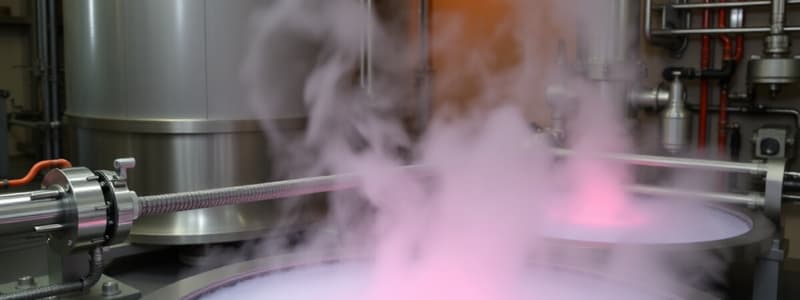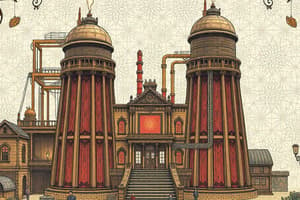Podcast
Questions and Answers
What is the formula for total thermal resistance in heat removal from nuclear reactors?
What is the formula for total thermal resistance in heat removal from nuclear reactors?
- $R = \frac{1}{4 \pi k_f H} + \frac{1}{2 k_c A} + \frac{1}{hA}$
- $R = \frac{1}{4 \pi k_f H} + \frac{1}{2 \pi k_c H} + hA$
- $R = \frac{1}{2 k_f A} + \frac{1}{k_c A} + \frac{1}{hA}$ (correct)
- $R = \frac{1}{2 k_c A} + \frac{1}{hA} + \frac{1}{4 \pi k_f H}$
Which of the following equations represents the heat transfer coefficient for turbulent flow?
Which of the following equations represents the heat transfer coefficient for turbulent flow?
- $h = 0.023 \left(\frac{D}{\nu} \right) Re^{0.8} Pr^{0.4}$
- $h = 0.023 \left(\frac{D}{k}\right) Re^{0.4} Pr^{0.8}$
- $h = 0.023 \left(\frac{k}{D}\right) Re^{0.8} Pr^{0.4}$ (correct)
- $h = 0.023 \left(\frac{k}{\mu} ight) Re^{0.8} Pr^{0.4}$
In the equation $T_m - T_b = R q_{max}$, what does $T_m$ represent?
In the equation $T_m - T_b = R q_{max}$, what does $T_m$ represent?
- Temperature at the coolant inlet
- Average temperature of the fluid (correct)
- Temperature at the coolant outlet
- Maximum temperature at the boundary
What role does the term $q_{max}$ play in heat removal from a nuclear reactor?
What role does the term $q_{max}$ play in heat removal from a nuclear reactor?
Which parameter is NOT part of the calculation for Reynolds number ($Re$)?
Which parameter is NOT part of the calculation for Reynolds number ($Re$)?
What is the purpose of analyzing heat generation and heat removal in a reactor?
What is the purpose of analyzing heat generation and heat removal in a reactor?
Which equation represents the thermal resistance in a reactor?
Which equation represents the thermal resistance in a reactor?
What is indicated by the term DNBR in a reactor?
What is indicated by the term DNBR in a reactor?
According to the Dittus-Boelter equation, what factors influence the heat transfer coefficient (h)?
According to the Dittus-Boelter equation, what factors influence the heat transfer coefficient (h)?
What does the term qmax represent in the context of DNBR?
What does the term qmax represent in the context of DNBR?
What is a significant advantage of boiling in nuclear reactors?
What is a significant advantage of boiling in nuclear reactors?
What is the minimum DNB ratio required for a Boiling Water Reactor (BWR)?
What is the minimum DNB ratio required for a Boiling Water Reactor (BWR)?
Which type of reactor allows extensive boiling?
Which type of reactor allows extensive boiling?
At what temperature does significant fission gas release occur for metal uranium?
At what temperature does significant fission gas release occur for metal uranium?
What happens during Departure from Nucleate Boiling (DNB)?
What happens during Departure from Nucleate Boiling (DNB)?
How does the hot channel factor (HCF) influence reactor power?
How does the hot channel factor (HCF) influence reactor power?
What condition characterizes the Boiling Water Reactor (BWR) operational pressure and temperature?
What condition characterizes the Boiling Water Reactor (BWR) operational pressure and temperature?
Which phenomenon is associated with a rapid increase in fuel temperature due to changes in boiling dynamics?
Which phenomenon is associated with a rapid increase in fuel temperature due to changes in boiling dynamics?
What is the consequence of lowering the minimum DNB ratio in a reactor?
What is the consequence of lowering the minimum DNB ratio in a reactor?
What is the critical heat flux and how can it be optimized?
What is the critical heat flux and how can it be optimized?
What type of boiling promotes more effective heat transfer by encouraging bubble formation?
What type of boiling promotes more effective heat transfer by encouraging bubble formation?
What factor influences the flattening of the flux shape in a reactor?
What factor influences the flattening of the flux shape in a reactor?
What is the purpose of ensuring cladding integrity in reactor design?
What is the purpose of ensuring cladding integrity in reactor design?
What happens when the hot channel factor is reduced?
What happens when the hot channel factor is reduced?
Which correlation is used for Critical Heat Flux (CHF) in bulk boiling scenarios?
Which correlation is used for Critical Heat Flux (CHF) in bulk boiling scenarios?
What is the maximum operating temperature for uranium dioxide (UO2)?
What is the maximum operating temperature for uranium dioxide (UO2)?
Flashcards are hidden until you start studying
Study Notes
Heat Transfer in Nuclear Reactors
- Newton's law of cooling: Represents heat transfer based on the temperature difference (Tc - Tb).
- Total thermal resistance is comprised of conduction and convection, represented by multiple resistances in series.
- Heat transfer coefficients are crucial, with turbulent flow noted for high Reynolds number (Re) applications.
Boiling in Nuclear Reactors
- Boiling enhances heat transfer efficiency, allowing for lower coolant pressure and reduced cladding temperature.
- Boiling Water Reactor (BWR) utilizes extensive boiling with a direct steam cycle, while Pressurized Water Reactor (PWR) controls boiling to improve heat transfer through subcooled bulk water.
Boiling Regimes
- Boiling patterns include nucleate boiling where bubbles form on heated surface imperfections and can carry heat away effectively.
- Departure from Nucleate Boiling (DNB) occurs when conditions shift towards film boiling, resulting in decreased heat transfer and increased fuel temperatures.
Boiling Crisis
- Critical Heat Flux (CHF) is a significant parameter where loss of nucleate boiling leads to film boiling, worsening heat transfer conditions and raising fuel temperature.
- Correlations for CHF exist for both subcooled and bulk boiling, providing guidelines for maintaining optimal reactor performance.
Thermal Design of Reactor
- Key design philosophies emphasize maintaining fission product containment, ensuring cladding integrity, and preventing fuel melting.
- Melting temperatures for various fuels vary significantly, with Uranium dioxide (~5000°F) being notably high compared to Metal Uranium (~2070°F).
Safety Margins
- Departure from Nucleate Boiling Ratio (DNBR) measures safety against DNB, requiring minimum values of 1.9 for BWR and 1.3 for PWR.
- Hot Channel Factor (HCF) accounts for maximum heat channels compared to average heat channels, influencing reactor power output and efficiency.
Reactor Power Considerations
- Reactor power is influenced by flow patterns, heat flux density, and geometric factors in the fuel loading pattern.
- Optimizing reactor operation involves increasing critical heat flux, minimizing HCF, and ensuring confidence in DNBR metrics through thorough technical validation.
Summary Points
- Understanding heat removal via conduction and convection is essential for reactor design.
- The relationship between temperature and heat transfer rates is quantitatively described by specific equations.
- Key operational metrics—DNBR, HCF, and reactor power—must adhere to established thresholds for safe and efficient reactor operation.
Studying That Suits You
Use AI to generate personalized quizzes and flashcards to suit your learning preferences.




